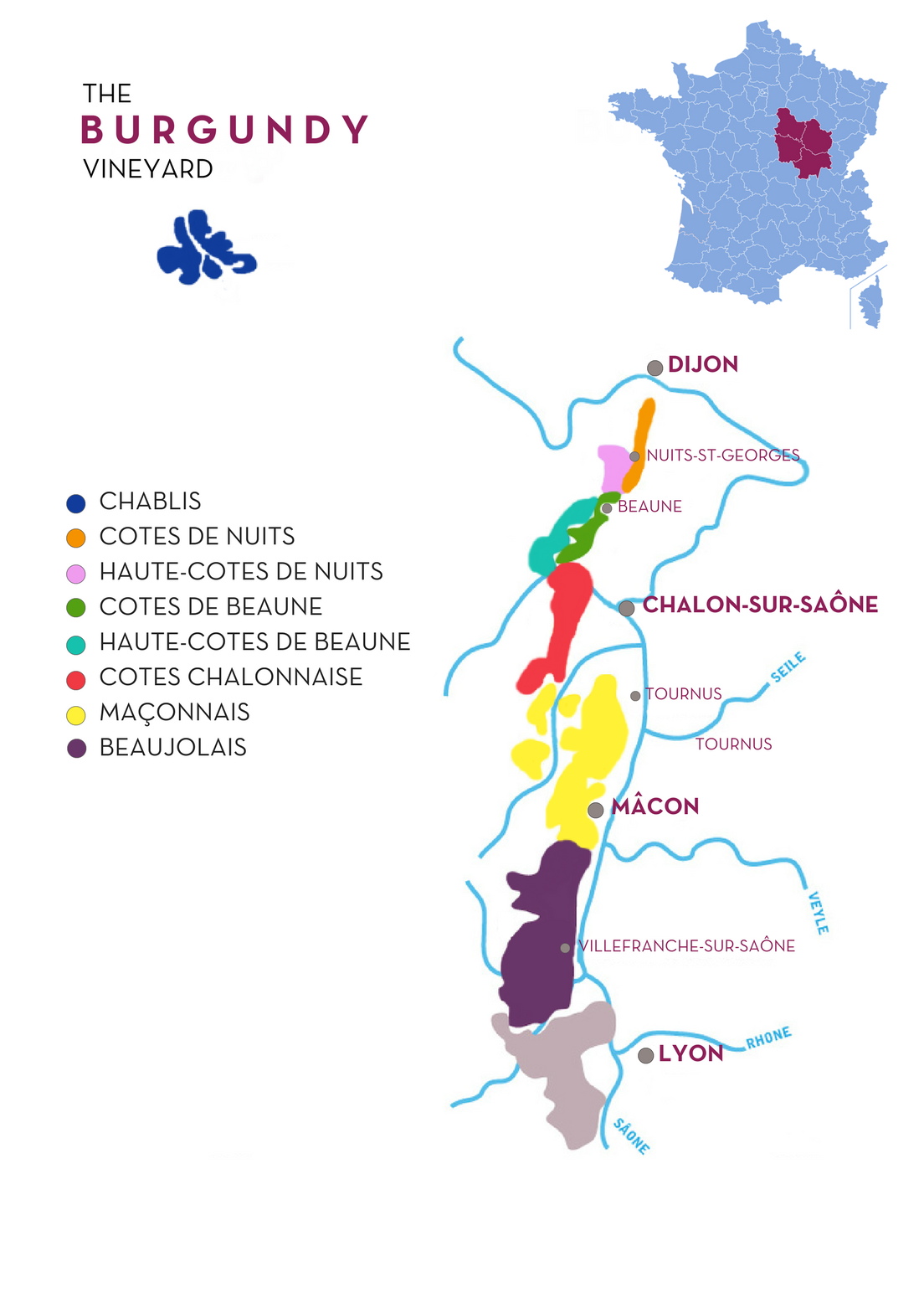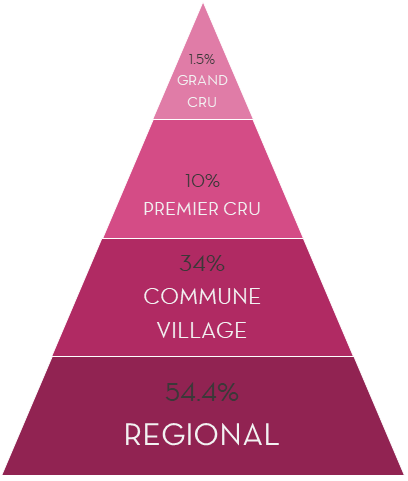Making Sense of Burgundy
If wine books were to start with a chapter on Burgundy I can guarantee you that most people would stop reading after a few pages. This region is the most complex and complicated in the world and even after studying for years I find that Burgundy can still be an enigma at times. You can pay a very high price and be disappointed, and you can pay a moderate one and be delighted. Yet some of the greatest wines on earth come from Burgundy and as most yachts carry one or several Burgundy wines on their list an introduction may come in handy. We promise we will make it as straight forward as possible!
The grapes
Fortunately, one aspect of Burgundy is easy and that is the grape varieties. All white wines are made of Chardonnay and all red wines are made of Pinot Noir (although Gamay is used in the subregion of Beaujolais). One can say that Burgundy is the spiritual home of these two top quality varieties. The typical Chardonnay from Burgundy will have received some oak ageing and have aromas of stone fruit, melon, and white flowers with a creamy texture. The Pinot Noir grape give wines that are fairly pale in colour compared to Cabernet or Syrah for example and often show aromas of red fruit, soft spice often with a leathery/earth undertone. Red Burgundy is typically very elegant and fragrant.
The regions
There are six main wine regions in Burgundy which in turn are divided into a myriad of smaller appellations, Premiere Crus and Grand Crus, but let’s start with the main ones.
Chablis - The most northerly region with the coolest climate producing crisp elegant wines with high acidity, minerality and aromas of citrus, green apples. Generally the wines in Chablis are unoaked although some of the Grand Cru wines receive some oak. There are 4 different quality levels within Chablis; Petit Chablis, Chablis, Chablis 1ere cru and Grand Cru. Only white wines are produced in this region.
Côte de Nuits - Côte de Nuits and Côte de Beaune is together called Côte d´Or (the golden hill side) and this is the heart of top quality Burgundy. Côte de Nuit is mostly famous for red wines communes such as Gevrey Chambertin, Chambolle Musigny, Vosne Romanée, Nuits Saint Georges and more.
Côte de Beaune - Although the two top quality red wine communes of Volnay and Pommard is located here, Côte de Beaune is mostly famous for the famous white wine communes like, Meursault, Puligny Montrachet and Chassagne Montrachet. These wines are medium bodied with aromas of melon, stonefruit and often with a floral element. They are oak aged have an elegant creamy yet refreshing palate.
Côte Chalonnaise - This is a region with little relevance for the yachting industry as charter guests and owners are after more famous names. Yet in terms of value for money there are some great villages to try for us regular consumers. Rouilly, Bouzeron and Montagny to name a few. Both red and white wines are produced and sometimes the difference between a 30€ Puligny Montrachet and a 15€ Montagny is very slight indeed.
Macônnais - With a slightly warmer climate than the Côte de Beaune, the Macônnais makes wines that are riper and rounder. The bulk of the production here is easy drinking, fairly light and fruit driven Chardonnay under the name Macôn or Macôn-Village. One commune however has a greater reputation and often finds its way to our industry and that is Pouilly-Fuissé. A fairly full bodied, generous Chardonnay often with plenty of ripe peach notes and toasty oak aromas.
Beaujolais - Some wine books include Beaujolais in the greater Bourgogne and some don’t. It actually makes more sense not to include it as it is actually made of another grape variety, Gamay with a specific wine making technique. The resulting wines are light with low tannins and easy drinking. Filled with crunchy red fruit characters and vegetal hints.
If it simply says Bourgogne Rouge or Blanc on a label it means it can be a blend from all the above regions. This will generally be quite esay drinking and simpler everyday wines
Terroir and the classification hierarchy
The classification system of Burgundy is very different to the one in Bordeaux. Here the classification is tied to the actual land and not the producer or Château. In Bordeaux a classified estate can buy additional vineyards and still keep the Grand Cru Classé classification and this is not possible in Burgundy. The classified land in Burgundy stays Grand Cru, Premier Cru or Village no matter what goes on in terms of vineyard sales. One might argue that this makes the Burgundy classification more “terroir” driven and authentic than the more economically driven classification of Bordeaux.
In Burgundy, terroir is a broad concept which includes both natural and human factors. It was wine growers (often monks) who discovered, identified and then developed the different terroirs of the region. Centuries of hard work were necessary to unfold the best sites of Burgundy and this discovery started in the early middle ages. It was passed down through generations and eventually officially recognized resulting in regional, commune/village, Premier Cru and Grand Cru appellations.
Today, after more than 1000 years, the terroir in Burgundy has been made into a modern concept which is copied all over the world. Wine growers aim to find the truest and most individual expression of their wines and to move away from industrial production.
As for the classification hierarchy it is often presented as a triangle with the base representing nearly half of the production in form of regional appellations like Bourgogne Rouge, Côte de Beaune, Côte Macônnais to name a few. The second layer consists of the communes which represents near 35%. Here you will find communes like Puligny Montrachet, Meursault, Gevrey Chambertin and many more. The third level is the 1ere crus, representing around 10% of the production coming from not less than 600 different 1ere cru sites! But not to worry, you won’t need to remember them, it clearly says 1ere cru on the bottle. The highest quality wines comes from one of the 33 Grand Cru vineyards which only represents around 1,5%.
Burgundy Labels
So if we look at a few labels from the Burgundy producer Olivier Leflaive it might become a bit clearer.
Regional
This Chardonnay from Côte de Beaune belongs to the base of the pyramid, the regional appellations. The grapes can come from a fairly large area and the sense of terroir/sense of place will not be as expressed like in the higher quality levels. These wines are best for drinking young and are not very age worthy.
Communal
For this label we have moved up a step in quality and are now looking at the commune level. The grapes will come from better soils from a smaller more defined area and show greater concentration of flavour and depth.
Premier Cru
This is a label from a 1ere cru vineyard within the commune of Chassagne Montrachet. It clearly says Premier Cru and then also the name Ruchotte, which is the name of the 1ere cru vineyard. At 1ere cry level, the wines should be of even higher quality exposing complexity, longevity and true sense of place along with minerality. There wines tend to be expensive and have obvious oak ageing.
Grand Cru
Finally at the top of our triangle we have the Grand Cru level. Montrachet Grand Cru is also within Chassagne Montrachet (actually it is a Grand Cru vineyard shared between Puligny Montrachet and Chassagne Montrachet) but now we are talking about the absolute best vineyard with perfect exposure and the best soils. The wines are rare and expensive. The Grand Cru wines only represents 1.5% of the output of Burgundy but for the yachting industry it represents a fair bit. The Grand Crus of Burgundy, be they red or white, should be truly great wines with lots of depth, complexity, elegance and a never ending length - all key components of quality in wine.












